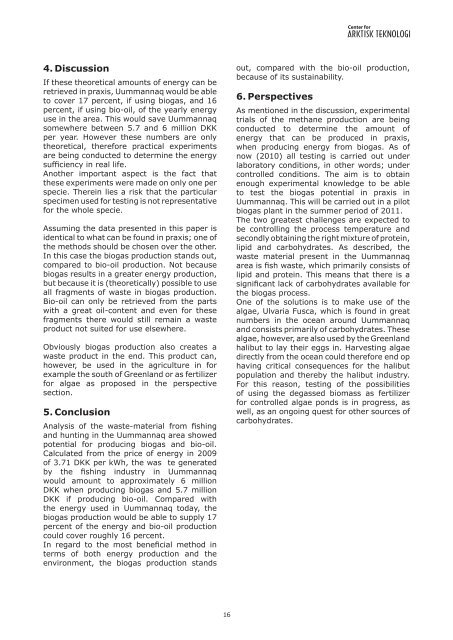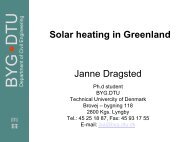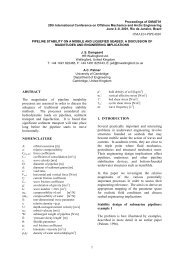Energiforsyning i Arktis – hvilken vej vælger Grønland? - Artek ...
Energiforsyning i Arktis – hvilken vej vælger Grønland? - Artek ...
Energiforsyning i Arktis – hvilken vej vælger Grønland? - Artek ...
You also want an ePaper? Increase the reach of your titles
YUMPU automatically turns print PDFs into web optimized ePapers that Google loves.
4. Discussion<br />
If these theoretical amounts of energy can be<br />
retrieved in praxis, Uummannaq would be able<br />
to cover 17 percent, if using biogas, and 16<br />
percent, if using bio-oil, of the yearly energy<br />
use in the area This would save Uummannaq<br />
somewhere between 5 7 and 6 million DKK<br />
per year However these numbers are only<br />
theoretical, therefore practical experiments<br />
are being conducted to determine the energy<br />
sufficiency in real life<br />
Another important aspect is the fact that<br />
these experiments were made on only one per<br />
specie Therein lies a risk that the particular<br />
specimen used for testing is not representative<br />
for the whole specie<br />
Assuming the data presented in this paper is<br />
identical to what can be found in praxis; one of<br />
the methods should be chosen over the other<br />
In this case the biogas production stands out,<br />
compared to bio-oil production Not because<br />
biogas results in a greater energy production,<br />
but because it is (theoretically) possible to use<br />
all fragments of waste in biogas production<br />
Bio-oil can only be retrieved from the parts<br />
with a great oil-content and even for these<br />
fragments there would still remain a waste<br />
product not suited for use elsewhere<br />
Obviously biogas production also creates a<br />
waste product in the end This product can,<br />
however, be used in the agriculture in for<br />
example the south of Greenland or as fertilizer<br />
for algae as proposed in the perspective<br />
section<br />
5. Conclusion<br />
Analysis of the waste-material from fishing<br />
and hunting in the Uummannaq area showed<br />
potential for producing biogas and bio-oil<br />
Calculated from the price of energy in 2009<br />
of 3 71 DKK per kWh, the was te generated<br />
by the fishing industry in Uummannaq<br />
would amount to approximately 6 million<br />
DKK when producing biogas and 5 7 million<br />
DKK if producing bio-oil Compared with<br />
the energy used in Uummannaq today, the<br />
biogas production would be able to supply 17<br />
percent of the energy and bio-oil production<br />
could cover roughly 16 percent<br />
In regard to the most beneficial method in<br />
terms of both energy production and the<br />
environment, the biogas production stands<br />
16<br />
out, compared with the bio-oil production,<br />
because of its sustainability<br />
6. Perspectives<br />
As mentioned in the discussion, experimental<br />
trials of the methane production are being<br />
conducted to determine the amount of<br />
energy that can be produced in praxis,<br />
when producing energy from biogas As of<br />
now (2010) all testing is carried out under<br />
laboratory conditions, in other words; under<br />
controlled conditions The aim is to obtain<br />
enough experimental knowledge to be able<br />
to test the biogas potential in praxis in<br />
Uummannaq This will be carried out in a pilot<br />
biogas plant in the summer period of 2011<br />
The two greatest challenges are expected to<br />
be controlling the process temperature and<br />
secondly obtaining the right mixture of protein,<br />
lipid and carbohydrates As described, the<br />
waste material present in the Uummannaq<br />
area is fish waste, which primarily consists of<br />
lipid and protein This means that there is a<br />
significant lack of carbohydrates available for<br />
the biogas process<br />
One of the solutions is to make use of the<br />
algae, Ulvaria Fusca, which is found in great<br />
numbers in the ocean around Uummannaq<br />
and consists primarily of carbohydrates These<br />
algae, however, are also used by the Greenland<br />
halibut to lay their eggs in Harvesting algae<br />
directly from the ocean could therefore end op<br />
having critical consequences for the halibut<br />
population and thereby the halibut industry<br />
For this reason, testing of the possibilities<br />
of using the degassed biomass as fertilizer<br />
for controlled algae ponds is in progress, as<br />
well, as an ongoing quest for other sources of<br />
carbohydrates





